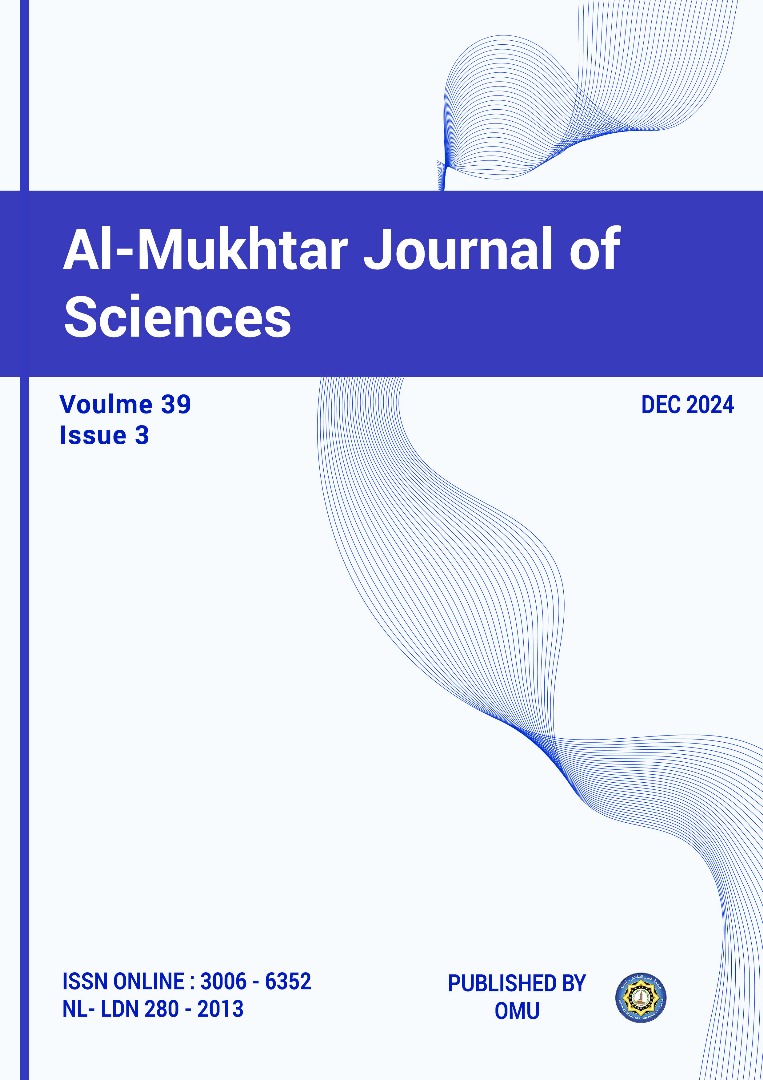Study of Risk Factors for Entamoeba Histolytica in Preschool Children: A Questionnaire Survey
- Authors
-
-
Saleha A. Algusbi
Department of Medical La-boratories, Faculty of Medical Technology, Surman, Sabratha University, LibyaAuthor -
Eyman I. Alrahal
Department of Medical Laboratories, Faculty of Medical Technology, Surman, Sabratha University, Libya.Author -
Eyman N. Almagbry
Department of Medical La-boratories, Faculty of Medical Technology, Surman, Sabratha University, LibyaAuthor -
Huda Z. Alkhweldy
Department of Medical Laboratories, Faculty of Medical Technology, Surman, Sabratha University, LibyaAuthor -
Nagah M. Hadlol
Department of Medical La-boratories, Faculty of Medical Technology, Surman, Sabratha University, LibyaAuthor -
Rayian R. Alzafiety
Department of Medical La-boratories, Faculty of Medical Technology, Surman, Sabratha University, LibyaAuthor -
Sawsan A. Aldarwesh
Department of Medical La-boratories, Faculty of Medical Technology, Surman, Sabratha University, LibyaAuthor -
Waad K. Alhrarie
Department of Medical La-boratories, Faculty of Medical Technology, Surman, Sabratha University, LibyaAuthor -
Wegdan N. Almagbry
Department of Medical La-boratories, Faculty of Medical Technology, Surman, Sabratha University, LibyaAuthor
-
- Keywords:
- Amebiasis, Entamoeba Histolytica, Pre-School Children, Risk Factors
- Abstract
-
Amebiasis is a parasitic infection of the intestines caused by a protozoa Entamoeba histolytica (E. histolytica) that mainly leads to diarrhea. A study was conducted to determine the prevalence of risk factors for Entamoeba histolytica infection. A study was carried out to assess the occurrence of risk factors for Entamoeba histolytica infection among children in the western region of Libya. A total of 55 children, 27 male and 28 female, with an average age of 2 and 5 years, were included in this study. Their mothers were interviewed using a structured questionnaire survey. The majority (61.82%) consumed water that originated from treated water, and most, (81.82%) consumed washed fruits before eating. All respondents consumed Well-cooked meat, washed their hands before eating (70.91%), while in contact with soil (87.27%), washed their hands after entering the bathroom (90.91%), and did nail trimming (85.45%). The majority of mothers had some knowledge about E. histolytica but little knowledge of the transmission mechanism. Understanding these risk factors can aid in reducing and preventing E. histolytica infection. More health education is required for the study to increase awareness of Entamoeba risk factors.
- Downloads
-
Download data is not yet available.
- References
-
Ali, M. B., Ghenghesh, K. S., Aissa, R. B., Abuhelfaia, A., & Dufani, M. (2005). Etiology of childhood diarrhea in Zliten, Libya. Saudi medical journal, 26(11), 1759-1765.
Clark, C. G., & Diamond, L. S. (2002). Methods for cultivation of luminal parasitic protists of clinical importance. Clinical microbiology reviews, 15(3), 329-341.
El-Boulaqi, H., Dar, F., & Medini, M. (1980). Prevalence of intestinal parasites in primary school children in Benghazi City.
El Ammari, N. E., & Nair, G. A. (2015). Critical evaluation of the intestinal Protozoan parasites among Libyan and other African residents of Al-Khoms, Libya. J Entomol Zool Stud, 3, 42-46.
Elsaid, M., Shaktur, A., Elsaid, S., EL-Alem, M., Traish, K., & Kahbar, F. (2014). Prevalence of intestinal protozoa in primary schools in Zawia City, Libya. Nat Sci, 12, 67-71.
Escolà-Vergé, L., Arando, M., Vall, M., Rovira, R., Espasa, M., Sulleiro, E., Armengol, P., Zarzuela, F., & Barberá, M.-J. (2017). Outbreak of intestinal amoebiasis among men who have sex with men, Barcelona (Spain), October 2016 and January 2017. Eurosurveillance, 22(30), 30581.
Farthing, M. J. (2006). Treatment options for the eradication of intestinal protozoa. Nature Clinical Practice Gastroenterology & Hepatology, 3(8), 436-445.
Feachem, R. (1983). Sanitation and Disease: Health Aspects of Excreta and Wastewater Management: John Wiley and Sons.
Fotedar, R., Stark, D., Beebe, N., Marriott, D., Ellis, J., & Harkness, J. (2007). PCR detection of Entamoeba histolytica, Entamoeba dispar, and Entamoeba moshkovskii in stool samples from Sydney, Australia. Journal of clinical microbiology, 45(3), 1035-1037.
Gathiram, V., & Jackson, T. (1987). A longitudinal study of asymptomatic carriers of pathogenic zymodemes of Entamoeba histolytica. South African Medical Journal, 72(10), 669-672.
Gunther, J., Shafir, S., Bristow, B., & Sorvillo, F. (2011). Amebiasis-related mortality among United States residents, 1990–2007. The American journal of tropical medicine and hygiene, 85(6), 1038.
Haque, R., Huston, C. D., Hughes, M., Houpt, E., & Petri Jr, W. A. (2003). Amebiasis. New England journal of medicine, 348(16), 1565-1573.
Haque, R., & Petri Jr, W. A. (2006). Diagnosis of amebiasis in Bangladesh. Archives of medical research, 37(2), 272-275.
Hasan, H. K., Mero, W. M. S., & Mohammed, A. B. (2023). Prevalence of amoebiasis and associated risk factors among population in Duhok city, Kurdistan Region, Iraq. The Journal of Infection in Developing Countries, 17(04), 542-549.
Hung, C.-C., Ji, D.-D., Sun, H.-Y., Lee, Y.-T., Hsu, S.-Y., Chang, S.-Y., Wu, C.-H., Chan, Y.-H., Hsiao, C.-F., & Liu, W.-C. (2008). Increased risk for Entamoeba histolytica infection and invasive amebiasis in HIV seropositive men who have sex with men in Taiwan. PLoS neglected tropical diseases, 2(2), e175.
Jackson, T., Gathiram, V., & Simjee, A. (1985). Seroepidemiological study of antibody responses to the zymodemes of Entamoeba histolytica. The Lancet, 325(8431), 716-719.
Kasssem, H. H., Zaed, H. A., & Sadaga, G. A. (2007). Intestinal parasitic infection among children and neonatus admitted to Ibn-Sina Hospital, Sirt, Libya. Journal of the Egyptian Society of Parasitology, 37(2), 371-380.
Kow-Tong, C., Chien-Jen, C., & Chiu, J.-P. (2001). A school waterborne outbreak involving both Shigella sonnei and Entamoeba histolytica. Journal of environmental health, 64(4), 9.
Mergani, M. H., Mohammed, M. A.-S., Khan, N., Bano, M., & Khan, A. H. (2014). Detection of intestinal protozoa by using different methods. Dentistry and Medical Research, 2(2), 28-32.
Nyarango, R. M., Aloo, P. A., Kabiru, E. W., & Nyanchongi, B. O. (2008). The risk of pathogenic intestinal parasite infections in Kisii Municipality, Kenya. BMC public health, 8, 1-6.
Ohnishi, K., & Murata, M. (1997). Present characteristics of symptomatic amebiasis due to Entamoeba histolytica in the east-southeast area of Tokyo. Epidemiology & Infection, 119(3), 363-367.
Peterson, K. M., Singh, U., & Petri Jr, W. A. (2011). Enteric amebiasis. In Tropical infectious diseases: principles, pathogens and practice (pp. 614-622). Elsevier.
Pham Duc, P., Nguyen-Viet, H., Hattendorf, J., Zinsstag, J., Dac Cam, P., & Odermatt, P. (2011). Risk factors for Entamoeba histolytica infection in an agricultural community in Hanam province, Vietnam. Parasites & vectors, 4, 1-9.
Ravdin, J. I., Jackson, T. F., Petri Jr, W. A., Murphy, C. F., Ungar, B. L., Gathiram, V., Skilogiannis, J., & Simjee, A. E. (1990). Association of serum antibodies to adherence lectin with invasive amebiasis and asymptomatic infection with pathogenic Entamoeba histolytica. Journal of Infectious Diseases, 162(3), 768-772.
Rawat, A., Singh, P., Jyoti, A., Kaushik, S., & Srivastava, V. K. (2020). Averting transmission: A pivotal target to manage amoebiasis. Chemical Biology & Drug Design, 96(2), 731-744.
Rinne, S., Rodas, E. J., Galer-Unti, R., Glickman, N., & Glickman, L. T. (2005). Prevalence and risk factors for protozoan and nematode infections among children in an Ecuadorian highland community. Transactions of the Royal Society of Tropical Medicine and Hygiene, 99(8), 585-592.
Sadaga, G. A., & Kassem, H. H. (2007). Prevalence of intestinal parasites among primary schoolchildren in Derna District, Libya. Journal of the Egyptian Society of Parasitology, 37(1), 205-214.
Schuster, F. L., & Visvesvara, G. S. (2004). Amebae and ciliated protozoa as causal agents of waterborne zoonotic disease. Veterinary parasitology, 126(1-2), 91-120.
Walsh, J. A. (1986). Problems in recognition and diagnosis of amebiasis: estimation of the global magnitude of morbidity and mortality. Reviews of infectious diseases, 8(2), 228-238.
WHO, W. H. O. (2011). Initiative for vaccine research: parasitic disease. Malaria http://www who int/vaccine_research/diseases/soa_parasitic/en/index4 html (accessed May 26, 2013).
WHO, W. H. O. (2012). Soil-transmitted helminthiases: eliminating as public health problem soil-transmitted helminthiases in children: progress report 2001-2010 and strategic plan 2011-2020. World Health Organization.
- Downloads
- Published
- 2024-12-31
- Issue
- Vol. 39 No. 3 (2024)
- Section
- Articles
- License
-
Copyright (c) 2024 Saleha A. Algusbi, Eyman I. Alrahal, Eyman N. Almagbry, Huda Z. Alkhweldy, Nagah M. Hadlol, Rayian R. Alzafiety, Sawsan A. Aldarwesh, Waad K. Alhrarie, Wegdan N. Almagbry (Author)

This work is licensed under a Creative Commons Attribution-NonCommercial 4.0 International License.
Copyright of the articles Published by Almukhtar Journal of Science (MJSc) is retained by the author(s), who grant MJSc a license to publish the article. Authors also grant any third party the right to use the article freely as long as its integrity is maintained and its original authors and cite MJSc as the original publisher. Also, they accept the article remains published by the MJSc website (except in the occasion of a retraction of the article).
How to Cite
Similar Articles
- Nasren G. S. Alfraik, Amera M. Mohmed, Aya S. Balhouq, Doaa F. Salih, Rajaa J. Saleh, Sana B. Aqoub, Obesogenic Factors in School-Aged Children in Tobruk City, Libya , Al-Mukhtar Journal of Sciences: Vol. 40 No. 1 (2025)
- Asma Albarasi, Hana Saied Abdulali, Amal A. Elfakhri, Hala Ammar, Prevalence and Risk Factors of Cholelithiasis Among Children with Hereditary Hemolytic Anemia: A Single Center Experience Benghazi, Libya , Al-Mukhtar Journal of Sciences: Articles in press
- Haleemah A. Al sheeyab, Hussain Alkhamry, Salem Omaer, Riyad Bendardaf, Cochlear Implant Complications in Children: Libyan Scenario and Experience , Al-Mukhtar Journal of Sciences: Vol. 39 No. 1 (2024)
- Soad Ajroud, Raga A. Elzahaf, Yassmin El hassady, Maternal Mortality at Al-Wahda Tertiary Hospital/ Derna -Lybia , Al-Mukhtar Journal of Sciences: Vol. 39 No. 1 (2024)
- Mabrouka A. Bofarraj, Faiza M. Ali, Hameeda F. Essay, Reema S. Salem, Rania .M. Altaib, Fatema. I. Mahmoud, Prevalence of Congenital Heart Disease Among Preterm Newborns Between 28 and 35 Weeks Admitted at Al Bayda Medical Center, Libya (2021) , Al-Mukhtar Journal of Sciences: Vol. 39 No. 1 (2024)
- Aeshah A. Altayf, The Level of 25-Hydroxy Vitamin D3 in Gingival Crevicular fluid and Serum Pre-Post Scaling and Root Planning in Chronic Periodontitis Patients in Western Libya: Comparative Study , Al-Mukhtar Journal of Sciences: Vol. 38 No. 4 (2023)
- Taher I. Shailabi, Nisreen Saed Majeed, Elham O. Borwis, Nagat H. Bubtina, Non-Compliance of Patients with Antibiotic Prescriptions , Al-Mukhtar Journal of Sciences: Vol. 38 No. 3 (2023)
- Khalifa KH Alqazaar, Fatma A. Alsadeg, Influence of Age, Sex, and Refractive Error on Intraocular Pressure Measurement Using Applanation Tonometer Among Healthy Individuals in Shahat , Al-Mukhtar Journal of Sciences: Vol. 39 No. 2 (2024)
- Faria M. Elbabour, Role of Otoacoustic Emissions in Hearing Assessment of Children with Autism , Al-Mukhtar Journal of Sciences: Vol. 38 No. 4 (2023)
- Osama Ahmadi, Mubarakah Abraheem, Aisha Aloshiby, Ibtisam Ahmadi, Areej EL-Sallak, Aram Elhashem, Hunaida Budajaja, Exploring the Role of Sociodemographic Factors in Influencing Dental Floss Knowledge and Practices among Adults in Sebha City, Libya: A Cross-Sectional Study , Al-Mukhtar Journal of Sciences: Vol. 40 No. 1 (2025)
You may also start an advanced similarity search for this article.

















